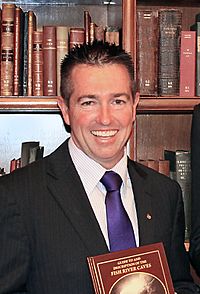Deputy Premier of New South Wales facts for kids
Quick facts for kids Deputy Premier ofNew South Wales |
|
|---|---|

|
|

|
|
| Department of Premier and Cabinet | |
| Style | The Honourable |
| Member of |
|
| Reports to | Premier of New South Wales |
| Seat | 52 Martin Place, Sydney |
| Nominator | Premier of New South Wales |
| Appointer | Governor of New South Wales
on the advice of the premier
|
| Term length | At the Governor's pleasure |
| Formation | 16 May 1932 |
| First holder | Sir Michael Bruxner |
The Deputy Premier of New South Wales is a very important leader in the Government of New South Wales. They are like the second-in-command, right after the Premier. This job has been around since 1932. The Governor chooses the Deputy Premier, but only after the Premier suggests who it should be.
Right now, the Deputy Premier is Paul Toole. He started this role on October 6, 2021. Mr. Toole also works as the Minister for Police and the Minister for Regional New South Wales. The Deputy Premier is ultimately responsible to the Parliament of New South Wales.
Contents
History of the Deputy Premier Role
The job of Deputy Premier was officially created in May 1932. The first person to hold this title was Michael Bruxner. He was the leader of the Country Party, which is now known as the National Party. Before 1932, people sometimes used the term "deputy premier" unofficially for the second-highest minister in the government.
Who Becomes Deputy Premier?
In governments led by the Labor Party, the Deputy Premier is usually the party's deputy leader. Often, this person comes from a different part of the party than the Premier.
In governments formed by the Liberal Party and National Party working together (called a Coalition), the Deputy Premier is always the leader of the National Party.
Deputy Premiers Who Became Premier
Three people who were once Deputy Premier later became the Premier of New South Wales. These were Joseph Cahill, Robert Heffron, and Jack Renshaw. However, this has not happened since 1964.
What Does the Deputy Premier Do?
The Deputy Premier has several important duties. Their main job is to act for the Premier when the Premier is away, like on a trip overseas or on vacation.
Part of the Cabinet
The Deputy Premier is always a member of the Cabinet. The Cabinet is a group of top ministers who make important decisions for the state. The Deputy Premier always has at least one other job, like being a minister for a specific area. They never just hold the title of Deputy Premier by itself.
Taking Over for the Premier
If the Premier were to pass away, become unable to do their job, or resign, the Governor would usually appoint the Deputy Premier as the new Premier. If the main political party had not yet chosen a new leader, this appointment would be temporary. If a different leader is later chosen by the party, that person would then become the official Premier.


